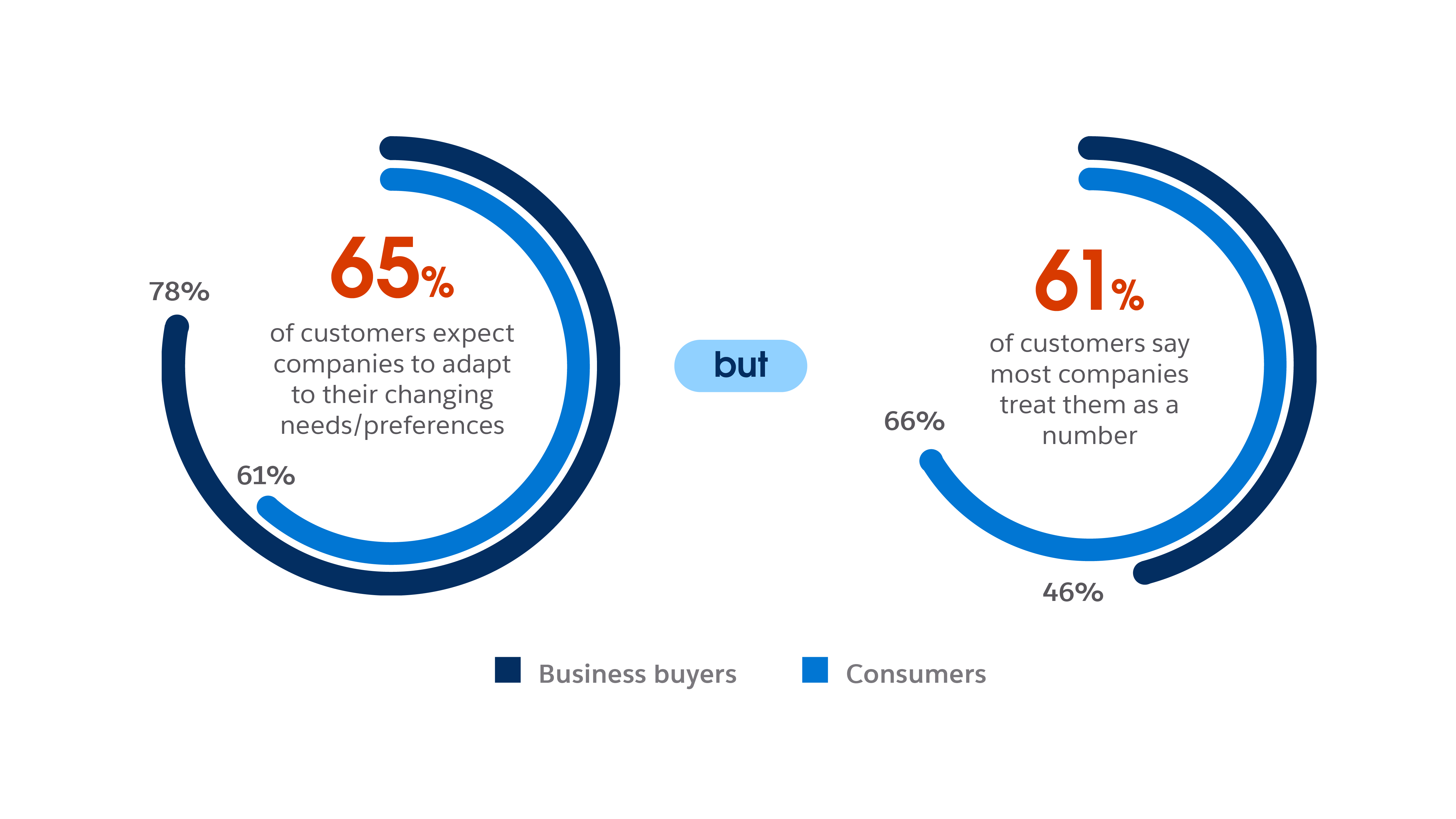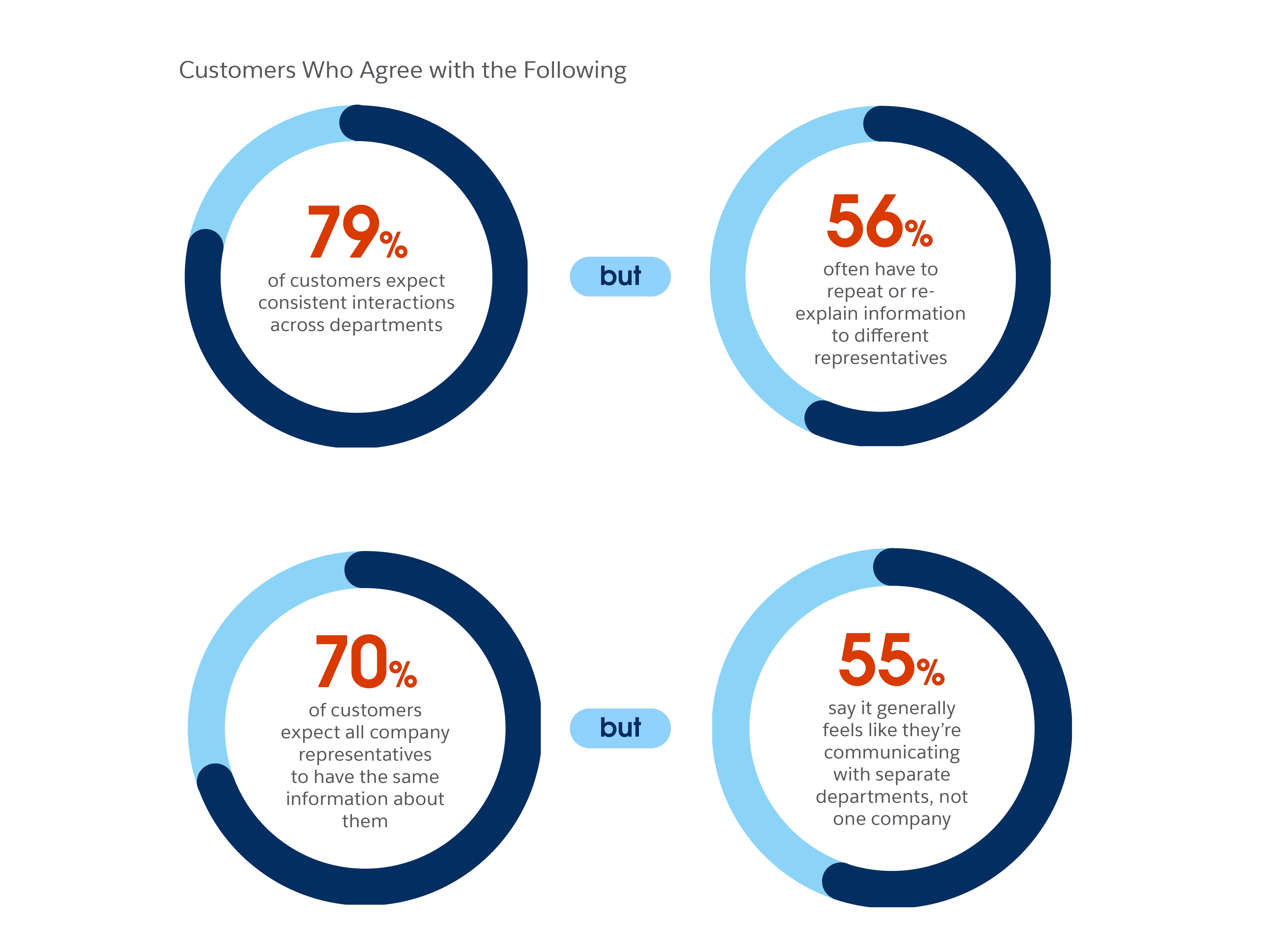What Is Customer Engagement? Key Findings from Global Research To Help Your Business Grow
What are the best customer engagement tools, and how can you keep your customers engaged? Our chief digital evangelist shares what works.
Time to read: 11 minutes
Chief Digital Evangelist, Salesforce
Media and content experiences like Hulu and Netflix use behaviour, data, and technology to tailor content to your interests – and set the standard for personalised customer engagement. And increasingly, consumers expect brands to know them, anticipate their needs and interests, and serve them only the content and products they want. Customer engagement has never been more important.
According to our State of the Connected Customer report, 80% of customers say the experience a company provides is as important as its products and services. Standards of customer engagement are changing, and engagement is about creating seamless experiences that build trust. Seventy-nine percent of customers expect consistent interactions across departments, and 80% say customer experiences should be better considering all the data companies collect.
What is customer engagement?
Customer engagement is delivering connected experiences to your customers instead of single, one-off, or fleeting transactions. It means optimising your team structure, operations, and technology to create a connected feedback loop with customers. Businesses need to stay informed about customers’ evolving needs, maintain and build their brand integrity, and make ethical use of customer data to help customers have the best experience.
Personalised customer engagement relies on an integrated tech stack. For example, a connected CRM gives your company a single, 360-degree view of every customer. With this insight, your teams can use data to tailor content and experiences to your customers’ unique needs, and help your brand keep pace with rising customer expectations.
Why are customer engagement strategies so important?
Our research found that 80% of customers say the experiences provided by a company are as important to them as its products and services. In other words, the quality of your customer experience has a direct impact on your potential for business success.
“Most companies must realise that they are no longer competing against the guy down the street or the brand that sells similar products,” said Dan Gingiss, author and customer experience expert. “Instead, they’re competing with every other experience a customer has. This presents an opportunity for forward-thinking brands to create positive experiences that customers want to talk about to others. It also suggests that CX [customer experience] professionals should be monitoring the experience at a wide variety of companies and industries for inspiration.”
Additionally, every time a brand raises the bar in its industry, it raises the bar for every other industry as well.
“Customers have so much power now,” said Neeracha Taychakhoonavudh, EVP of Industries at Salesforce. “In the consumer world of social platforms, every single person has a voice. The rewards of harnessing your most ardent fans are amazing, but customers will also be very vocal when they are displeased. Knowing your customers and understanding their needs has become critical to success, no matter what industry you’re in.”
How do you measure customer engagement for marketing, sales, and service?
Measuring customer engagement isn’t always easy.
- Is a customer who visited your website 10 times last week more engaged than one who spent 15 minutes talking to a sales rep on the phone?
- Is a new customer who made five recent purchases more engaged than a long-time customer who only buys once a year?
- Do your answers to these questions change if one customer completes an online survey or recommends your brand to others?
Success looks different for everyone depending on their business goals. Here are some key metrics different departments should monitor.
Customer engagement for marketing.
While the “right message, right channel, right time” mantra still applies, it’s a complicated practice to master. The average customer crisscrosses many different channels on different devices.
Engaging in real time is a marketers’ top priority — and top challenge. Many track mobile and social analytics, in addition to general web traffic and digital engagement rates, to better optimise across media. Forty-eight percent of marketers also track lifetime customer value, the ultimate measure of whether they’re effectively engaging customers and providing the experiences they expect.
“Measuring customer lifetime value is a great start, because it will likely convince companies to invest more in existing customers,” said Dan Gingiss. “That’s as opposed to continuing the infinite loop that is spending on acquisition without regard to the ‘leaky bucket’ on the other end.”
Customer engagement for sales.
Customer engagement for service.
Customer satisfaction remains the ultimate goal and the most-tracked customer service KPI. But in modern service centres, data analytics have brought more granular measures of engagement.
For example, 69% of service teams now track first contact resolution (FCR) rates, and the same number track customer effort scores. Sixty-seven percent even track case deflection, a measure of how many customer issues they’re able to prevent in the first place.
How do you build an effective customer engagement strategy?
Deliver personalised customer experiences.
Connect customer experiences across every department.
Sixty-four percent of customers use multiple devices to start and complete single transactions, and the average enterprise uses 900 different applications, only 29% of which are connected. Whether speaking to sales or customer service, in-store or online, over three-quarters of customers expect your brand to speak with one voice.
That means customers’ historical data needs to be accessible to every department. Anyone at your company should be able to quickly access customer information and engage them accordingly – without peppering them with mundane, repetitive questions.
Many companies find it a challenge to live up to these expectations. Fifty-five percent of customers said they feel like they’re interacting with siloed departments rather than a unified business. For companies, ensuring a high level of connectivity across channels and devices feels difficult, if not impossible – unless you have the right tools.
Create reliable and instant customer response.
Seventy-three percent of customers expect better personalisation as technology advances. As customers get to personalised engagement, those investments become increasingly critical: 65% of consumers say they will remain loyal to companies that offer a more personalised experience.
What does highly personalised engagement look like? Customers rely on many tools, products, and services to help them work from anywhere, connect with friends, and manage their lives. With so many tools, products, and services at their fingertips, customers know what top-end experiences look like. In fact, 53% say they expect companies to anticipate their needs — whether it's serving up a customised marketing offer or proactively reaching out to prevent a potential issue.
Get started with Salesforce and customer engagement.
Become one of the companies to respect customer data and use it to improve their experience with your brand – building their trust and loyalty along the way. With personalised, consistently connected, real-time communication throughout every customer touchpoint, businesses can use data to find new and compelling ways to engage customers and keep them coming back.
Learn how Salesforce Customer 360, the world’s #1 CRM, helps you engage your customers.

Guide
The Transformation Playbook

Guide
Salesforce Customer 360 Playbook
More Resources

Blog

Research

